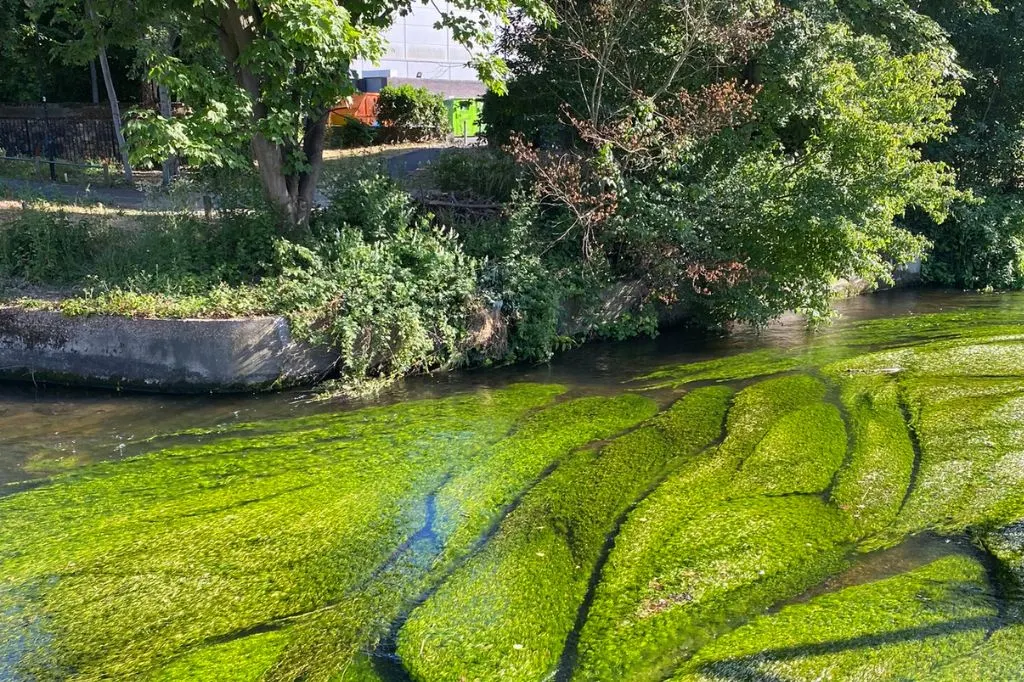After you leave Merton High Street, the Wandle Trail takes you past the former site of the William Morris factory. This post has everything you need to know about the history of William Morris in Merton, including a map showing where the original factory once stood.

William Morris Factory Merton
Who Was William Morris
William Morris was born in Walthamstow in 1834 into a wealthy family, and took an interest in the arts from an early age. He was best known as a textile designer, but was also a poet, craftsman and early socialist.
In 1853 Morris went to Oxford University to study Theology, with the intention of pursuing a career in the church. It was at Oxford where he met his lifelong friend Edward Burne-Jones (the painter and designer), his wife Jane Burden, and Pre-Raphaelite painter Dante Gabriel Rossetti.
Both Morris and Burne-Jones had planned to become clergyman, but after after an architectural tour of the churches and cathedrals in northern France and Belgium, both men realised they were more committed to art.
In 1861 Morris set up an interior design company with his friends from Oxford. The company produced wallpapers, rugs and tapestries that were all hand made.
In 1875 Morris become the sole director of the company, and by 1881, had made enough money to buy Merton Abbey Works. This was adjacent to Merton Abbey Mills, which later became the home of the Liberty Print Works.
Merton Abbey Works had been used for calico printing since 1752. When William Morris acquired the factory, it allowed him to bring all his workshops together in one place. The factory remained open after Morris’ death in 1896, finally closing in 1940.

History of William Morris in Merton
After Morris purchased the Merton Abbey Works in 1881, he refused to change any of the existing buildings apart from some minor alterations. They remained largely the same from when he bought them until the factory closed in 1940.
The factory site had been a calico printing works since 1752, and was owned by the Welch family who used the works to produce table-cloth.
At the Merton Abbey factory, Morris paid his workers higher than average wages, built a library for their education, and a dormitory for the apprentice boys. He believed strongly that art couldn’t flourish in a society of “commercialism and profit mongering”, and that Socialism was “the only hope of the arts.”
Timeline of William Morris’ Life
The timeline below shows the events in William Morris’ life.
| Year | Event |
|---|---|
| 1834 | William Morris was born into a wealthy family. |
| 1852 | Morris studied Theology at Exeter College, Oxford University. |
| 1861 | William Morris created a furnishings and decorative arts company where everything was created by hand. The company called “Morris, Marshall, Faulkner & Co” was created jointly with Ford Madox Brown, Edward Burne-Jones, Charles Faulkner, Dante Gabriel Rossetti, P. P. Marshall, & Philip Webb. |
| 1875 | William Morris took over total control of the company and renamed it Morris & Co. It produced wallpapers, furniture, fabric, tapestries, and stained glass windows. |
| 1877 | Morris opened a shop on Oxford Street to sell carpets, rugs, embroidery and tapestry. |
| 1881 | Morris bought Merton Abbey Works (textile mills) by the River Wandle in South London. This brought the company’s workshops together in one place. |
| 1896 | William Morris died. |
| 1940 | The William Morris factory, Merton Abbey Works closed. |
Where was the William Morris factory?
William Morris’ factory was in Merton right next to the River Wandle. It was an ideal location for Morris. There was already silk printing and calico printing on the site, and the water from the River Wandle was perfect for washing silk fabric.
The area, which was nine acres in total, allowed Morris to bring all his workshops together in one place. This included weaving, dyeing, cotton-printing, tapestry and stained glass production.
The site of the old factory is where the Sainsburys and Marks & Spencers is today. On the map below, the red dot marks the place where can see the plaque where the factory once stood.

The photograph below shows the plaque that can be found along the River Wandle Trail. Morris was pleased to have his factory so close to Merton Priory, and also Merton Place where Nelson once lived.

Did William Morris live in Merton?
Although William Morris acquired a textile factory in Merton, he never actually lived there. At the time when Morris bought Merton Abbey Works he was living in Kelmscott House in Hammersmith.
Throughout his lifetime William Morris lived in the following houses:
- 17 Red Lion Square (Bloomsbury) – 1856 – William Morris and Edward Burne-Jones, moved to 17 Red Lion Square which had previously been occupied by Rossetti and Deverell.
- Red House (Kent) – 1860 – Morris moved into the Red House with his wife Jane.
- 26 Queen Square (Bloomsbury) – 1865 – William Morris moved to Queen Square with his family and lived above the firm’s shop.
- Kelmscott Manor (Oxfordshire) – 1871 – This was Morris’ summer home. He signed a joint lease with Dante Gabriel Rossetti in 1871.
- Kelmscott House (Hammersmith) -1878-1896 – Morris moved to Kelmscott House three years after he took over control of the design company. He remained here until his death in 1896.

Liberty at Merton Abbey Mills
William Morris’ Merton Abbey Works was adjacent to Merton Abbey Mills which later became to home of the Liberty Print Works.
Before acquiring Merton Abbey Mills, Arthur Liberty, worked with the silk dyer Thomas Wardle, who printed silks for William Morris. Wardle helped Liberty to use vegetable dyes to create subtle colours on silk.
Liberty used the print works at Merton Abbey Mills from the late 1870s, and took over the site completely in 1904. The mill continued to print fabrics for Liberty until 1977.
You can still see the original print shops that were built by Liberty at Merton Abbey Mills.

The photograph below shows the plaque on the building where the silk was pressed before printing.

The photograph below shows the River Wandle. It was taken from the Wandle Trail in between the site of the former William Morris factory, and Merton Abbey Mills.

This Post Was About the William Morris Factory in Merton
Thank you for reading my post about the William Morris Factory. If you are walking the Wandle Trail, the site of the former William Morris Factory is in between Wandle Park and Merton Abbey Mills.

Alan Boys
Sunday 8th of January 2023
Hiya, I was born in colliers Wood 1951,next to wandle Park, school was singlegate infants ,then fortescue back to single gate ,great times ,my dad lived of byegrove Rd...Bailey Road, gone now ,anyone remember
Ken G Hawkes
Sunday 23rd of October 2022
Thank you Olivia for all the content and information about the River Wandle Park , It is very much appreciated Ken Hawkes
Olivia Herlihy
Sunday 23rd of October 2022
Hi Ken, I'm glad the information was helpful. :-). Thanks for your comment. Olivia
Ken G Hawkes
Sunday 23rd of October 2022
Hi All After many years searching! Have just this Merton site, so good and very helpful, my dad and mum moved us down to the then South Road in Merton in early years of the 2nd world war, South Road used to run from The Recreation Park (the rec) down to the River Wandle and the Then Connelles Leather Factory sitting Astride the Wandle, I did visit there in 2003 and of course I think there were apartments now, can anyone confirm that the Connelly leather company used to be there?, I will be visiting again in new year and hope to find out more info and possibly meet up with anybody that had links with that area, I used to play in the River adjacent to the Connelly factory and remember it so clearly, there was a Vicarage on the opposite corner with very high wall, it was always a mystery what was behind the wall!!👀, any links or persons or relatives would be so nice to be able to find out more about the area, my dad was a leather stainer in Connoleys Kind Regards Ken Hawkes
Tel: 01702817088 Mob: 07850345340
Olivia Herlihy
Sunday 23rd of October 2022
Hi Ken, Thanks for your comment and kind words about my site. I think Connolly’s Leather Mill was one of the most famous leather mills on the river Wandle - making leather for Jaguar, Bentley and Rolls Royce cars. Maybe see you down by the river when you next come to visit. I'd love to hear your memories of the old leather factory. :-) Kind regards, Olivia